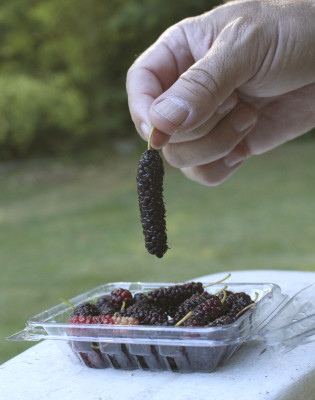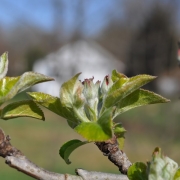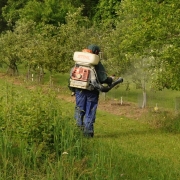DOING SOMETHING ABOUT (MICRO)CLIMATE CHANGE
Microclimates, Here, There, and Everywhere
Mark Twain wrote that “Everyone complains about the weather but nobody does anything about it.” I’m going to step up to the plate and do something about it — not the climate but the microclimate. “Microclimate” is the very local weather. And I do mean “very local,” as, for example, right around a particular plant.
Different microclimates exist all around my property — and yours. Near the south wall of my brick house for example, winter low temperatures don’t plummet nearly as low as they do, say, 30 feet away from the wall. The bricks are very good at absorbing the sun’s heat, then let it slowly ooze out after nightfall. Near that wall is where I’m planning to plant out a Kadota fig tree now dormant in my basement. (Come late fall, after harvest, I’ll dig up the tree with a good root ball and return it to winter quarters in the basement.)

‘Surround’, a white clay, sprayed on apples
On the other side of my house, where sunlight can’t fall in winter, days and nights are colder than the general temperatures, and remain colder from spring through fall. Near that north wall, then, would be a good place to plant an apricot or peach tree to delay unfolding of their blossoms, which otherwise open so early that they often succumb to subsequent spring frosts. Dead blossoms mean no crop for that season.
Apricots and peaches, like most fruits need sunlight to fuel the most flavorful fruits. Although areas near the north wall are shaded — and hence cooler — in winter, from spring through early fall the sun wraps enough around the sky from the northeast to northwest corners to cast its light there.
Other influences on microclimate include fences, land sloping in various directions, paved areas, plant or built windbreaks, and changes in elevation.
(Micro)Climate Modification
Much of what I have planted, including many fruit plants, are nowhere near fences or paving, and my land is mostly flat. It is lowland, in a valley, and cold air, which is heavier than warm air, collects in this low spots, to threaten the blossoms on my fruit plants with late, killing frosts.
Mark Twain notwithstanding, I’m going to try doing something about the weather — the microclimate, in this case — on plants nowhere near walls, fences, or paving.
Enter ‘Surround’, the trademark name for a special formulation of kaolin clay. This product was developed about 30 years ago mostly as a nontoxic way to thwart insect pests. It’s especially useful for controlling plum curculio, a pest of plums, peaches, apples, and some other fruits; curculio isn’t easily controlled by other organic methods.

‘Surround’ spray on blueberries
Kaolin is white, so when a sufficiently thick coating of ‘Surround’ is built up on branches, they appear white. Old Sol’s rays just bounce off white surfaces, the surfaces, in this case being the buds of fruit plants. So the buds stay cooler, delaying bloom, hopefully until after threat of frost has past.
I’ve already given the plant a couple of coats of ‘Surround’, and they already have a sun-drenched, gray-cast, Mediterranean look to them. A couple more coats will make the visual effect more dramatic, both to me and Ol’ Sol, and will get a jump on curculio control.
Awake too Soon
Downstairs, in the basement, things are not as quiescent as hoped. That’s where the figs, pomegranates, and mulberries are spending winter, the cool (45°F) temperature holding back growth. Or so I thought.
One plant, Pakistan mulberry, has decided to awaken. This mulberry is a species of white mulberry (Morus alba) that differs markedly from the white mulberries you see here. Pakistan is only about as cold-hardy as fig (which is why they share winter quarters in my basement) and bears a very delicious, dark purple fruit up to three inches long!

‘Pakistan’ mulberry
Pakistan evidently has a low chill requirement, that is, it does not take much cold for it to feel like winter has ended so it can begin growing. Different plants have different requirements for the number of hours of chilling, which is temperatures between about 30 and 45°F., they need to be exposed to before they can begin growth for the season.
I may have to move the budding plant into the greenhouse where it really is spring, with temperatures at least into the 70s on this sunny day.




ever posted on the Makrut lime tree / leaf? It is used it Thai cuisine. Might be fun to get a cutting from the nearest Thai restaurant that grows one. I didn’t see it listed in your grow fruit naturally book. Maybe add it for edition 2 if one is planned. Love your posts!
https://en.wikipedia.org/wiki/Kaffir_lime
Thanks. But I never hear of the Makrut lime tree.
Kaffir is listed below. It might be more fun to make friends with someone who owns a Thai restaurant. They might have one.
http://briteleaf.com/citrus_trees.asp#LemonandLimeTrees
also, while reading their website, I came across a new word:
“budwood source”
What is that?
http://briteleaf.com/questions.asp
Bud wood source is the plant that supplies the budwood for grafting. You don’t need a whole stem as a scion for grafting. You could just use a single bud, as in bud grafting and chip budding. With these methods, you graft a single bud onto a stem, then the bud grows out into a new shoot, etc. The original stem is then cut back to just above the where the bud graft or chip bud was made.
I just went to a Thai restaurant on Long Island called “Thai Angel.”
They grow their own peppers and spices and Kaffir Lime leaves.
They said they have 20 Kaffir lime trees in a green house. In this climate they only produce small fruit that do not appear very healthy. In Thailand, they said the Kaffir lime trees produce much more fruit.
They mainly use the Kaffir lime leaves for cooking.
It’s one of the freshest tasting Thai restaurants I’ve ever been to.
https://www.zagat.com/r/thai-angel-islandia
The zagat scores on long island seem inflated; however, this food score seems accurate.
If you are in NYC area, this family would probably be a good family to get a cutting from.
Do you have any seeds of the Pakistan Mulberry to share?
Contact me in a couple in a few weeks. The small plants are loaded with fruit and I’ll see if they have seeds. My guess is that they will not.
Lee, The good news is that the Russian Ribes are alive and well. Was wondering if I could get seed of a “Pakistan” Mulberry and if they are hard to grow from seeds.
David
Contact me in a couple in a few weeks. The small plants are loaded with fruit and I’ll see if they have seeds. My guess is that they will not.